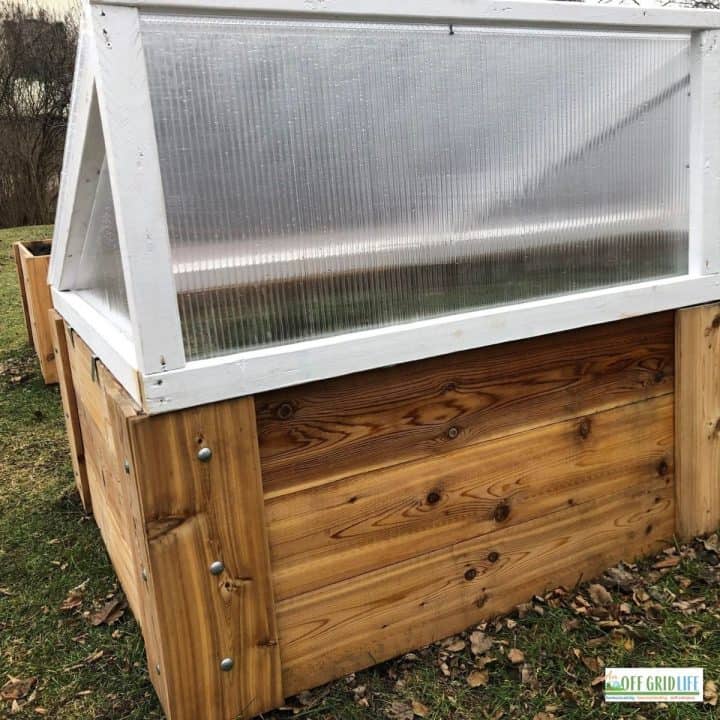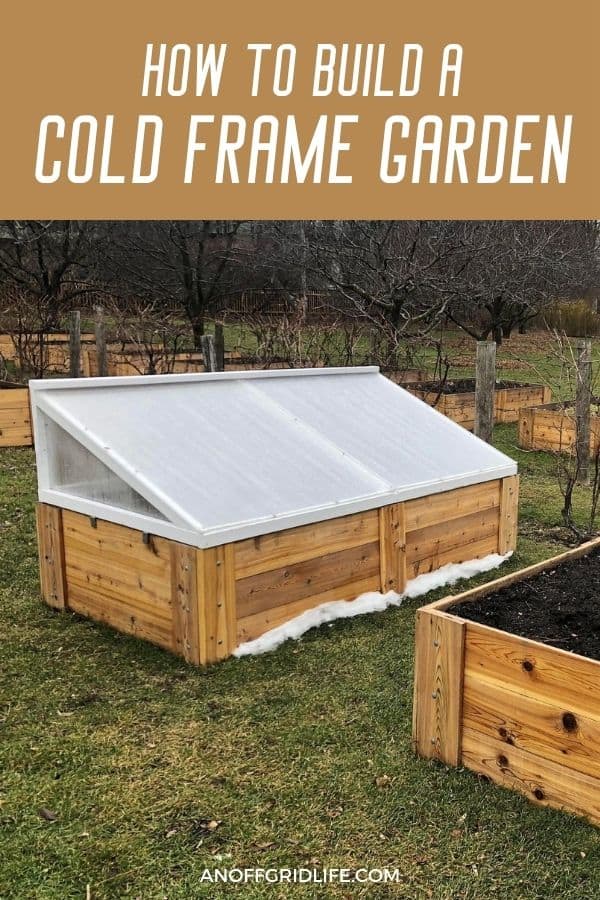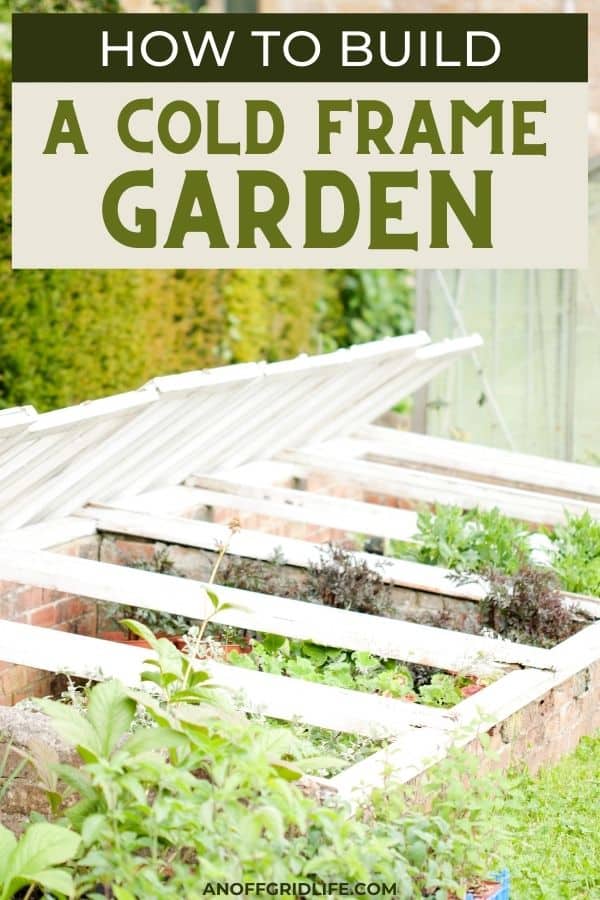Cold frame gardening has been used for generations to extend the harvest season in home gardens. These gardens help retain heat and protect plants from the elements like snow, wind, and cold temperatures. With the right plan, cold frame gardens provide an easy way to turn old materials into a frugal DIY greenhouse.
Building a proper cold frame garden allows you to harvest your own vegetables throughout the autumn and into the winter months. Many people gardening in a cold climate also use them in late spring to harden off seedlings and prepare them for outdoor conditions.
These tips will help you get started with cold frame gardening and help you learn about the benefits of having your own cold frame.
Estimated reading time: 7 minutes

What is Cold Frame Gardening?
Cold frame gardening can best be described as a miniature, unheated greenhouse. It involves building a low wooden or polycarbonate frame around a garden section and placing a hinged, transparent covering over the top.
Common materials used for the transparent covering include old windows and doors. Glass in the windows and doors let sunlight pass through but retain heat within the structure.
The hinged lid of a cold frame garden must be positioned facing the south. This allows optimal sunlight exposure during the winter months.
Some people will also place straw bales or other protective insulators on the north side of the cold frame. This helps stop cold winds and other winter conditions from affecting the garden.
Why Use Cold Frame Gardening?
Gardeners and homesteaders find cold frame gardens useful for a few reasons. They help insulate plants and protect them from the colder conditions in late autumn and early winter.
This allows gardeners to harvest fresh vegetables and greens from their garden into December. Even with two feet of snow on the ground, you will still get harvestable plants in your cold frame.
If you want to jump-start the growing season, use a cold frame garden to start seedlings outside in early spring.
Since early spring will still be quite cold, when planning your garden, make sure you choose crops that handle cold weather well, like lettuce, cabbages, and most perennials.
Another common use for cold frame gardens involves “hardening off” plants.
Start seedlings and plants indoors throughout the winter, and transplant them directly into the soil of the cold frame in early spring.
From here, they become gradually acclimatized to the outdoor conditions by opening the lid a bit during warmer days.
Where to Find Materials For Your DIY Cold Frame Garden

Although you can buy a pre-made kit to build a cold frame garden, why not use the old materials you have available?
A DIY cold frame gives you a creative way to repurpose old windows, shower doors, or other thick transparent materials.
Old scraps of wood will work great to build the frame. Add a couple of hinges on the transparent lid, and you have a rudimentary cold frame garden.
Get creative with the materials, and insulate the box as tightly as possible. Use hay or straw bales to set up protective barriers around the garden, but be careful not to block out the sunlight.
If you don’t have all the materials you need, try visiting your local Habitat for Humanity Restore.
These locations often have fantastic amounts of reusable building materials at a very low price. Depending on your local dump, you will likely find a lot of hidden building treasures there too.
When to Get Started?
When to build your cold frame garden depends on how you want to use it.
You may use them during every season, and since they have a variety of uses, I would suggest getting started as soon as possible.
Start planning now, and your cold frame will be ready to go before you know it.
Figure out the ideal place in your garden to build a cold frame, and make sure it has enough exposure to sunlight.
Start building your cold frame in a garage or workshop in the meantime, so it will be ready to go as soon as the weather cooperates.
How to Plan/Design a Cold Frame
While you will find many basic cold frame garden designs online, creating your own custom design will allow you to tailor it to fit your needs and materials.
Figure out what materials you have, what ones you need to get, how much space you have in the garden, and what plants you intend to use the cold frame for. At the very least, you will need:
- Basic hand tools (saw, drill, screws)
- 2 x 4 lengths of wood, preferably hardwood
- An old window or door (some type of transparent semi-insulated material)
- Hinges
To learn more about building a basic cold frame garden, check out this free resource from The Old Farmer’s Almanac.
If you’d prefer to use a different design, try out this tutorial from Fine Gardening.
You will notice many different designs available, so find one that best suits your needs. If you can’t find the right one, create your own and let us know your preferred style.
What to Put Inside
This might seem pretty obvious, but don’t put tall plants inside your cold frame.
Make sure you choose plants that won’t be too restricted by the confines of your cold frame. This means any plants that need to climb or have long, tall stalks will be hindered by the low height of your lid.
Depending on the time of year, you will have different plants inside your cold frame. In the spring, you will use it to help transition indoor seedlings to the outdoor climate.
In the late autumn and winter months, it will be used to protect plants that will survive in colder temperatures when necessary.
Deciding on what types of plants to put in your cold frame will vary depending on your region and average monthly temperatures.
Research different varieties of vegetables and figure out what will perform best in your climate with a cold frame garden.
Plant Hardiness Zone Maps
To help you get started, take a look at the USDA's Plant Hardiness Zone Map.
This map was designed to help gardeners determine which plants will thrive in their respective regions. You will notice detailed maps for each specific state broken down by ZIP codes.
For our Canadian readers, the Natural Resources Canada page has the same resources for our provinces and territories.
Cold frame gardening gives you a simple and frugal way to extend your growing season.
You can build a basic cold frame from extra materials in your garage or shed, and add a new resource to your gardening tool belt. This will help you get plants in the ground sooner and keep them there longer.
Try building your own at home and let us know what plants do well in your own cold frame garden.
Interested in learning more about gardening off the grid in a cold climate? Continue reading below.
LIKE THIS POST? SAVE IT TO YOUR FAVOURITE PINTEREST BOARD FOR LATER!



